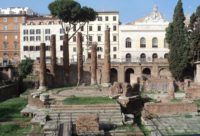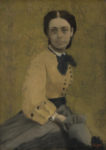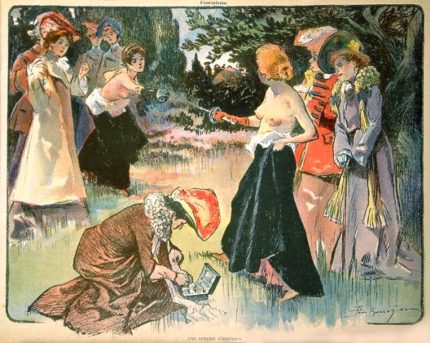 The School of Athens by Raffaello Sanzio is widely considered the visual embodiment of the rebirth of classical philosophy and art that gave the Renaissance its name. Raphael painted the fresco for the Stanza della Segnatura, the room in the Vatican housing Pope Julius II’s library, between 1509 and 1511. The artist started with a full-scale preparatory cartoon in charcoal, red and white chalk on paper in 1508-9. It was massive, over nine feet high and 26 feet wide, and was made by gluing together 210 pieces of “royal paper” (large format sheets about 12×16 inches in dimension). More than 50 individuals, the great philosophers of antiquity centered around Plato and Aristotle, populate the cartoon, with only a couple of figures from the final fresco missing, including Heraclitus, whose face is said to be a portrait of Michelangelo, then working just down the hall on the ceiling of the Sistine Chapel. It is the largest surviving Renaissance cartoon.
The School of Athens by Raffaello Sanzio is widely considered the visual embodiment of the rebirth of classical philosophy and art that gave the Renaissance its name. Raphael painted the fresco for the Stanza della Segnatura, the room in the Vatican housing Pope Julius II’s library, between 1509 and 1511. The artist started with a full-scale preparatory cartoon in charcoal, red and white chalk on paper in 1508-9. It was massive, over nine feet high and 26 feet wide, and was made by gluing together 210 pieces of “royal paper” (large format sheets about 12×16 inches in dimension). More than 50 individuals, the great philosophers of antiquity centered around Plato and Aristotle, populate the cartoon, with only a couple of figures from the final fresco missing, including Heraclitus, whose face is said to be a portrait of Michelangelo, then working just down the hall on the ceiling of the Sistine Chapel. It is the largest surviving Renaissance cartoon.
Raphael was employed by Pope Julius on the recommendation of Bramante to fresco the room. The commission served a political role as much an aesthetic one. There were already frescoes on the walls by Piero della Francesca, but he had been hired Alexander VI whose papacy was already infamous. Julius was keen to cover the walls with new frescoes that would erase the imprint of his Borgia predecessor, a sort of damnatio memoriae by artistic proxy.
 Only 27 years old when he began The School of Athens, Raphael created a vision that transposed the ideas of Renaissance humanist thought into figural and architectural forms. The fluid lines of his initial drawing illuminate his creative process, the apparent ease with which he conceived an intricate mural that would take two years to complete. It’s also the only version of The School of Athens done entirely by Raphael’s own hand. He had staff to help him paint the fresco itself.
Only 27 years old when he began The School of Athens, Raphael created a vision that transposed the ideas of Renaissance humanist thought into figural and architectural forms. The fluid lines of his initial drawing illuminate his creative process, the apparent ease with which he conceived an intricate mural that would take two years to complete. It’s also the only version of The School of Athens done entirely by Raphael’s own hand. He had staff to help him paint the fresco itself.
He used the cartoon as a literal outline, poking holes (still clearly visible today) through the lines of the faces, garments, folds and bodies. Because the completed cartoon was so massive, it could not be applied smoothly all at once to the plaster surface of the wall and have the trace-over last for two years of painting. Raphael instead used it to show Julius II a clear view of the full complex composition of the fresco and as a master template, drawing through the perforations onto individual papers just large enough to cover one day’s work.
 Even so, the cartoon matches the finished fresco almost exactly, with only a few centimeter’s difference on the right side. The architectural design on the top part of the fresco is not on the cartoon, or rather just the foundations of it are, barely visible and only spotted by researchers in 1972. Most of the remarkable vaulted gallery in deep one-point perspective that rises above and behind Plato and Aristotle was painted directly onto the plaster.
Even so, the cartoon matches the finished fresco almost exactly, with only a few centimeter’s difference on the right side. The architectural design on the top part of the fresco is not on the cartoon, or rather just the foundations of it are, barely visible and only spotted by researchers in 1972. Most of the remarkable vaulted gallery in deep one-point perspective that rises above and behind Plato and Aristotle was painted directly onto the plaster.
Even in Raphael’s all-too-short lifetime (he died at age 37) the cartoon was recognized as a masterpiece in its own right. It was described as the “well-finished cartoon” because the lion’s share of the information necessary for the fresco was included: the figures, the setting, the poses, the facial expressions, the direction of the light, the highlights and lowlights of his chiaroscuro.
 That a cartoon as delicate as it is massive survives intact after five centuries of wars, pillage and dispersed cultural patrimony is largely due to Cardinal Federico Borromeo (1564-1631), Archbishop of Milan and founder of the Biblioteca Ambrosiana, the second public library in Europe after the Bodleian. He was an erudite man, a prolific writer and connoisseur of the arts who amassed an immense collection of 45,000 manuscripts and books with the deliberate intent of creating a library that would be an invaluable resource for scholars.
That a cartoon as delicate as it is massive survives intact after five centuries of wars, pillage and dispersed cultural patrimony is largely due to Cardinal Federico Borromeo (1564-1631), Archbishop of Milan and founder of the Biblioteca Ambrosiana, the second public library in Europe after the Bodleian. He was an erudite man, a prolific writer and connoisseur of the arts who amassed an immense collection of 45,000 manuscripts and books with the deliberate intent of creating a library that would be an invaluable resource for scholars.
For a hundred years after its creation, the cartoon disappears from the historical record. It reappears in 1610 in a legal document stating that Fabio II Visconti Borromeo, Count of Brebbia (and holder of two far more excellent titles: Decurion of Milan and Judge of the Streets), loans the cartoon to Cardinal Borromeo until such time as Visconti requests its return. That time never came.
In 1618 the cardinal founded Pinacoteca Ambrosiana to house his great collection of paintings and drawings, including works by Caravaggio (Basket of Fruit) and Leonardo da Vinci (Portrait of a Musician) alongside Raphael’s cartoon, still technically on loan. It became officially part of the Ambrosiana collection in 1626 when the cardinal bought it from the count’s widow Bianca Spinola Borromeo for the then-astronomical sum of 600 imperial lire.
It remained at the Pinacoteca, one of its greatest treasures and biggest draws, until 1796 when the greatest scourge of Italy’s patrimony, Napoleon Bonaparte, entered Milan. Five days after his forces took the city, Napoleon proclaimed that Milan now owed France 15 million lire and any and all artworks of value. Dominique-Vivant Denon, director of the Louvre, was tasked with drawing up a list of Milan’s most important pieces that would be summarily pillaged and sent to the museum in Paris.
On June 25, 1796, box upon box of treasures from the Ambrosiana left Milan destined for the Louvre. Leonardo’s Musician was in them, his notebooks from the library’s collection and Raphael’s The School of Athens cartoon. It was subject to extensive restoration — relined with canvas, mounted on a new frame, missing parts filled in — before being put on display. After Napoleon’s defeat at Waterloo in 1815, the sculptor Antonio Canova was dispatched to the Louvre to reclaim the works taken from the Papal States. While he was at it, he arranged the return of the Ambrosiana’s stuff too. The cartoon was back in Milan by 1816.
It was restored again in 1887. This time the work done was even more extensive. The cartoon was reframed, and most significantly, was attached to a new canvas backing for support. The wars of the 20th century jerked it around some more. In 1915, with northern Italy the target of Austro-Hungarian aerial bombing, the cartoon went back to Rome for first time since it was drawn by Raphael 400 earlier. It was kept safe in the Vatican until the war was over. In 1942 it went underground, secured in the bank vault of the Cassa di Risparmio delle Provincie Lombarde, and good thing too because the Abrosiana was bombed and had to be rebuilt after the war.

The vicissitudes of the past two centuries left the cartoon worse for wear. The paper had yellowed (browned, even) making the chalk, charcoal and lead drawing hard to read and water damage was pervasive. It had also been mounted in a new frame and showcase in 1966, then state-of-the-art but inadequate for modern conservation techniques which require constant inspection and monitoring.
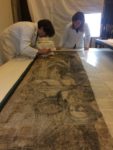 In 2014, the Ambrosiana launched an ambitious program of conservation and study. A team of experts from the College of Fellows of the Biblioteca Ambrosiana, the Higher Institute for Conservation and Restoration of the Vatican Museums, the Milan Superintendency and the Conservation and Restoration Centre “La Venaria Reale” worked with professors from several Italian universities to preserve the work, reverse old restoration errors and create a new showcase to protect the cartoon while make it entirely visible to visitors.
In 2014, the Ambrosiana launched an ambitious program of conservation and study. A team of experts from the College of Fellows of the Biblioteca Ambrosiana, the Higher Institute for Conservation and Restoration of the Vatican Museums, the Milan Superintendency and the Conservation and Restoration Centre “La Venaria Reale” worked with professors from several Italian universities to preserve the work, reverse old restoration errors and create a new showcase to protect the cartoon while make it entirely visible to visitors.
 Both front and back were treated. On a custom table with a moveable bridge that allowed conservators to hover over the surface, the cartoon was cleaned with low pressure micro-suction devices like those used in surgery. Old polymer glue used with strips of canvas in the 1966 restoration to expand the perimeter which had shrunk over time was removed. Conservators also repaired tears and lined the back with layers of Japanese tissue paper in different sizes and shapes to relieve stress on the supports and recover the original flatness of the cartoon. The last step was to apply a new canvas lining and mount the cartoon in a new frame.
Both front and back were treated. On a custom table with a moveable bridge that allowed conservators to hover over the surface, the cartoon was cleaned with low pressure micro-suction devices like those used in surgery. Old polymer glue used with strips of canvas in the 1966 restoration to expand the perimeter which had shrunk over time was removed. Conservators also repaired tears and lined the back with layers of Japanese tissue paper in different sizes and shapes to relieve stress on the supports and recover the original flatness of the cartoon. The last step was to apply a new canvas lining and mount the cartoon in a new frame.
Here’s a video of conservators in 2017 removing the first layer of Japanese tissue paper from the back of the cartoon a year after it was applied to stabilize it:
Here’s the conservation team applying canvas lining to the back of the cartoon:
After a year of study and three years of painstaking labour, the cartoon will return to its dedicated exhibition gallery at the Pinacoteca Ambrosiana on March 27th.
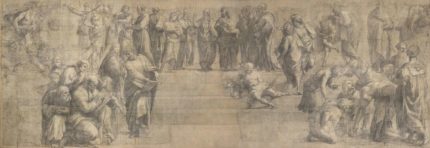
 A silver gilt cup found in the wreck of 17th century merchant ship in the Wadden Sea near the island of Texel, northern Holland, has been restored and put on display at the Kaap Skil Museum on Texel.
A silver gilt cup found in the wreck of 17th century merchant ship in the Wadden Sea near the island of Texel, northern Holland, has been restored and put on display at the Kaap Skil Museum on Texel.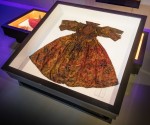 Known as the boxwood wreck, after its cargo of boxwood timbers, or Texel wreck, it was carrying artifacts of such exceptional quality that there was immediate speculation that it might have been transporting members of aristocracy, perhaps even royalty, or at least their stuff. A leather book cover stamped in gold with the coat of arms of King Charles I suggested a Stuart connection and in the initial excitement of the find, the silk gown was identified as having belonged to Jean Kerr, Countess of Roxburghe, lady-in-waiting to Queen Henrietta Maria. That hypothesis was disproved when researchers discovered the dress was made in Northwestern Europe, not England.
Known as the boxwood wreck, after its cargo of boxwood timbers, or Texel wreck, it was carrying artifacts of such exceptional quality that there was immediate speculation that it might have been transporting members of aristocracy, perhaps even royalty, or at least their stuff. A leather book cover stamped in gold with the coat of arms of King Charles I suggested a Stuart connection and in the initial excitement of the find, the silk gown was identified as having belonged to Jean Kerr, Countess of Roxburghe, lady-in-waiting to Queen Henrietta Maria. That hypothesis was disproved when researchers discovered the dress was made in Northwestern Europe, not England.  The silver gilt cup was also made in continental Europe, likely southern Germany. The cities of Nuremberg and Augsburg were known for their silversmiths who produced show cups like this. Unfortunately the seal that would precisely pinpoint the shop where it was made is missing, but the style of the cup dates it to the late 16th century, so at least 50 years before the ship’s last voyage, estimated to have taken place about 1650.
The silver gilt cup was also made in continental Europe, likely southern Germany. The cities of Nuremberg and Augsburg were known for their silversmiths who produced show cups like this. Unfortunately the seal that would precisely pinpoint the shop where it was made is missing, but the style of the cup dates it to the late 16th century, so at least 50 years before the ship’s last voyage, estimated to have taken place about 1650. When it was recovered from the water, the metal cup was in worse shape than the fine silk stockings. It was broken into three pieces and and severely dented, coated in heavy black corrosion. Most of the dents were repairable, thankfully, and the thick crust of corrosion was removed. Restorers worked on it for four years to reveal the intricate details of its decoration. It chased and molded with floral motifs, vases and masks. Standing on the lid is a figurine of Mars. He would have originally held a shield, now lost.
When it was recovered from the water, the metal cup was in worse shape than the fine silk stockings. It was broken into three pieces and and severely dented, coated in heavy black corrosion. Most of the dents were repairable, thankfully, and the thick crust of corrosion was removed. Restorers worked on it for four years to reveal the intricate details of its decoration. It chased and molded with floral motifs, vases and masks. Standing on the lid is a figurine of Mars. He would have originally held a shield, now lost.  The sometime showpiece is now a showpiece once again, on display from March 9th to September 9th at the museum’s exhibition of select objects from the boxwood wreck. The 450-page report on the wreck, Wereldvondsten uit een Hollands schip (World finds from a Dutch ship, according to the always questionable Google Translate) is available for sale at the museum. I couldn’t find it online, much to my disappointment, because I would nerd out all over that.
The sometime showpiece is now a showpiece once again, on display from March 9th to September 9th at the museum’s exhibition of select objects from the boxwood wreck. The 450-page report on the wreck, Wereldvondsten uit een Hollands schip (World finds from a Dutch ship, according to the always questionable Google Translate) is available for sale at the museum. I couldn’t find it online, much to my disappointment, because I would nerd out all over that.
